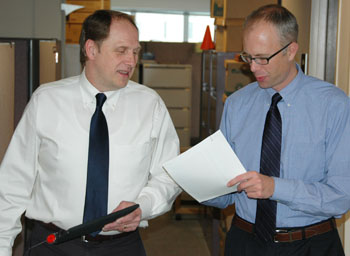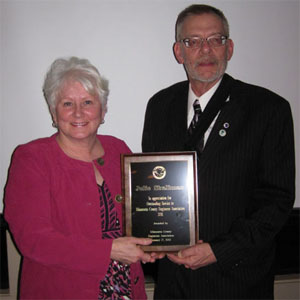 |
|

|
 |
TABLE of CONTENTS
 |
Mix of winter weather sweeps across state |

Strong winds from a winter storm Feb. 29 produce large swells on Lake Superior along Old Hwy 61 in Duluth. Photo by Beth Petrowske |
Snow, slush, rain and ice arrived in Minnesota Feb. 28, blanketing the majority of the state and causing challenging road conditions for motorists.
In northern Minnesota, heavy blowing snow created poor visibility and hazardous driving conditions, prompting the closure of all Minnesota state offices in Aitkin, Pine, Carlton, St. Louis and Lake counties. The closure did not include state employees required to work during weather emergencies.
District 1 advised no travel Feb. 29 in the southeastern portion of the district as strong winds and heavy snow contributed to reports of visibility of only one-eigth mile. The storm kept snow plow crews busy near Pine City and Sandstone as more than 10 inches of snow fell in the area.
Further west in District 4, crews were busy keeping up with the 10 inches of snow that fell in the Alexandria area. Roads in the district were listed in difficult condition due to ice patches and snow compaction.
The winter weather caused headaches for motorists in the Twin Cities metro area during the evening and morning rush hours Feb. 28-29. A mixture of sleet and heavy wet snow created a slushy, slippery morning commute. By noon, 90 percent of state highways in the Twin Cities were clear of snow compaction, according to Mark Fischbach, Metro District clear roadways superintendent.
Crews in southern Minnesota dealt with similar conditions to those in the Twin Cities—slippery and slushy roads from wet snow and rain. |
 |
|

|
 |
TABLE of CONTENTS
 |
Congress passes Federal Aviation Administration authorization bill |
By Becky Dahlberg
President Barack Obama signed legislation Feb. 14 authorizing $63.4 billion during the next four years for Federal Aviation Administration programs to improve airport infrastructure and modernize the nation’s air traffic control system. The bill’s passage signifies compromise after being blocked for almost four years.
“We appreciate the passage of the four-year, long-term bill,” said Serge Phillips, Federal Relations manager. “This bill helps Minnesota airports by enabling them to plan projects over a four-year period of time because of committed funding levels. This will result in better projects and less administrative cost.”
According to the House Transportation and Infrastructure Committee, the bill:
- Contains no earmarks and does not raise taxes or passenger facility charges.
- Funds FAA safety programs, Next Generation Air Transportation System efforts and operations through 2015.
- Provides long-term stability for the aviation industry.
- Accelerates deployment of NextGen technologies.
- Provides for unprecedented reform of the National Mediation Board.
- Establishes a balanced inspection regime for repair stations.
- Establishes a process to address outdated and obsolete FAA air traffic control facilities, saving taxpayer money.
- Enacts airline passenger improvements and protections.
Philips said he is pleased the Essential Air Service program is part of the bill.
“The EAS program helps five communities in Minnesota keep airline service that they otherwise would be unable to provide.”
Those five communities are Thief River Falls, Bemidji, Brainerd, International Falls and Hibbing.
For more information about the FAA reauthorization bill, contact Serge Phillips at 651-366-3075. |
 |
|

|
 |
TABLE of CONTENTS
 |
Speed limits, bonding projects among top transportation issues of 2012 session |
|
By Lisa Yang

From left, John Bieniek and Erik Rudeen, Government Affairs, share notes from a legislative committee meeting. Photo by Nick Carpenter |
MnDOT is following several transportation-related proposals this legislative session that could have negative impacts on road safety, including a bill that calls for increasing the current statutory speed limit of 55 mph to 60 mph.
“We are working with DPS and other agencies to protect the advancements made in the last few years through Toward Zero Deaths and other safety initiatives,” said Erik Rudeen, Government Affairs. “This bill also will affect all local roads statewide and many of them are too narrow or can’t handle 60 mph.”
In addition, legislative committees are hearing presentations from the department about bonding for local bridges, MnDOT buildings, ports, Greater Minnesota transit and replacement of highway-railroad grade crossing warning devices.
The Transportation Policy Omnibus Bill didn’t make it through the legislature last year; however, it is moving along steadily this year, according to Rudeen. The bill includes several MnDOT initiatives that have passed the transportation committees. The Senate bill is awaiting action by the full Senate, while the House Ways and Means Committee must act on the bill before it is sent to the House floor.
One of the initiatives in the bill is the alternative financing authorization that allows MnDOT to undertake a pilot project and enter into agreements with public or private entities to finance or invest in transportation projects.
The targeted group business program is another initiative in the bill. The program allows MnDOT to provide a bid preference to veteran-owned small businesses that compete for state-funded transportation contracts and set goals for participation by these firms on MnDOT contracts.
A bill to consolidate state agencies and merge the department into a yet-to-be-determined agency also is moving through the Legislature this session. It’s not the first time this type of bill has been discussed, but it is moving along further than previous proposals have, according to Rudeen.
For more details and updates on these and other transportation-related bills, visit http://ihub/governmentaffairs/. |
 |
|

|
 |
TABLE of CONTENTS
 |
Department renews partnership agreement with CTS |
MnDOT and the Center for Transportation Studies at the University of Minnesota recently renewed their long-standing commitment to collaboratively advance transportation knowledge and foster innovations that improve Minnesota’s transportation systems and services.
“MnDOT considers this partnership to be very important to Minnesota’s transportation efforts,” said Bernie Arseneau, deputy commissioner and chief engineer. “It shows a strong bond and collaboration between Minnesota’s primary transportation agency and the state’s largest research and education institution.”
Arseneau is a member of the partnership leadership team along with Nick Thompson, Policy, Safety, and Strategic Initiatives Division director; and Laurie McGinnis, CTS director. A joint group of MnDOT and CTS employees are currently managing the partnership’s efforts:
- Jean Wallace, Office of Policy, Analysis, Research, and Innovation director
- Linda Taylor, Research Services Section director
- Dawn Spanhake, CTS assistant director
- Linda Preisen, CTS research administration director
The partnership has been in place since the inception of CTS in 1987. It formalized in 1995 with an agreement documenting the partnership’s mission, goals, strategies and structure.
The partnership has four main goals:
- Anticipate and identify trends, issues and needs that call for research, education and technology transfer activities to improve transportation decision-making
- Develop and manage research programs and projects that effectively address strategic transportation issues, and lead to problem-solving and innovation development by transportation professionals
- Act as a catalyst to transfer research findings, information and best practices for development, testing and implementation, resulting in enhanced tools, techniques, knowledge and skills for the current and future workforce
- Sustain transportation research, education and technology transfer programs that support MnDOT’s and the University of Minnesota’s role as national and international leaders in improving transportation systems
McGinnis cited several recent MnDOT-funded research projects at the University of Minnesota that have resulted in breakthrough innovations, including SMART Signal, a traffic management system for urban arterials, and the SAFL Baffle, a device that improves sediment control in urban stormwater runoff. Both innovations are being commercialized by local startup companies.
“This is an effective partnership that is making an impact,” McGinnis said. |
 |
|

|
 |
TABLE of CONTENTS
 |
Skallman receives County Engineers Association award |

Julie Skallman, State Aid Division director, receives a Minnesota County Engineers Association award from Rick West, Otter Tail County engineer. Photo by Mic Alm |
Julie Skallman, State Aid Division director, recently received a Minnesota County Engineers Association award for Outstanding Service.
MCEA is a support group for the 87 Minnesota county engineers. The association provides support for training, works on issues related to all counties, and advises legislative officials on transportation issues.
Skallman said it was “nice to get recognition” for the work she does.
The department's State Aid Division works closely with local levels of government to ensure the state maintains a safe, effective and coordinated highway network. In addition to funding support, State Aid:
- Provides technical assistance in highway and bridge design; construction and maintenance
- Authorizes grants for bridge construction
- Coordinates local federally funded projects
- Provides overall management of the state aid system
|
 |
|

|
 |
TABLE of CONTENTS
 |
Website home page gets makeover |
Employees who have visited MnDOT’s external website in the past few days may have noticed a few changes the home page.
In addition to some minor design changes, the page now features a live Twitter feed and more prominent links to social media services.
The changes were made with the help of MnDOT’s online community— a group of more than 600 Minnesotans created to encourage an open dialogue between the department and its customers to better understand their transportation-related needs and issues. The online community reviewed the page and provided feedback on ways to make the page more customer-friendly and focused on customer needs.
Employees can share their thoughts on the new home page by contacting the department’s WebTeam. |
 |
|
| |
|



